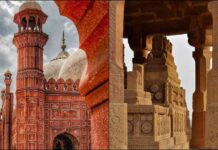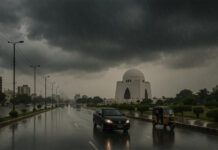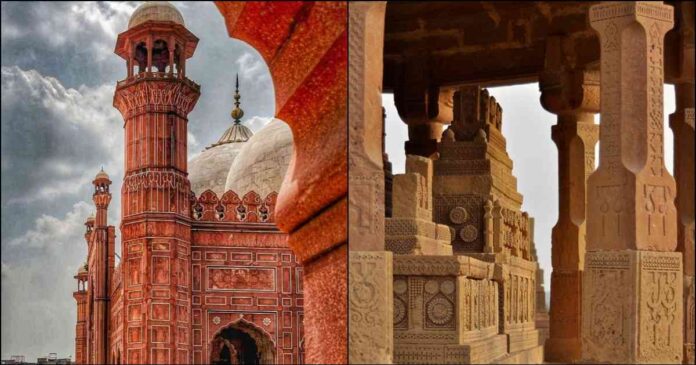Most of us have walked past these grand old structures in Pakistan and thought, “Nice building. Moving on.” However, the truth is that behind all the cultural monuments of Pakistan lies a story worth hearing.
Lahore Fort & Badshahi Mosque
In Lahore, two imposing siblings stand guard over the city’s rich history.
The Lahore Fort, a massive fortress built during Emperor Akbar’s reign in the 16th century, stands majestically in the heart of the city. Its Sheesh Mahal (Palace of Mirrors) and Naulakha Pavilion are celebrated for their intricate tile work and mirror mosaics.
Across the Hazuri Bagh, the Badshahi Mosque in Lahore, built by Emperor Aurangzeb in 1673, is one of the largest mosques in the world and a quintessential example of Mughal architecture. Constructed in red sandstone with marble inlays, its massive courtyard can hold up to 100,000 worshippers, making it a symbol of the Mughal Empire’s grandeur and power.
The site has endured Sikh stables and British barracks, and till today, it stands as a symbol of pride for Pakistan.
Rohtas Fort
Built by Sher Shah Suri in the 16th century, Rohtas Fort is Pakistan’s military marvel, which the Mughals later fortified to guard against invasions. Spread over 4 km, Rohtas Fort has 12 gates, with the Sohail Gate being the grandest.
Its blend of Afghan and Mughal architecture symbolises the power struggles of the era. The fort remains one of the best-preserved fortresses in South Asia and is listed as a UNESCO World Heritage Site.
Fun fact: It was meant to keep out the Mughals, but eventually, they took over anyway. Classic!
Makli Necropolis
Yes, it’s a cemetery. But not just any cemetery.
Makli Necropolis, located near the town of Thatta in Sindh, is one of the largest and oldest burial grounds in the world. It covers an area of over 10 square kilometres and contains tombs dating back to the 14th century.
From kings and queens to Sufi saints, everyone is buried here, and each grave tells a story of faith, art, and forgotten power. Walking through Makli feels like wandering through centuries.
Goosebumps, literal goosebumps!
Ranikot Fort
Onto the great wall of Pakistan (this is no exaggeration).
Tucked away in Sindh, Ranikot Fort is HUGE, like 30 km long huge! People call it the Great Wall of Sindh. No one’s totally sure who built it or why, which only adds to the mystery.
Some say it’s a Talpur-era creation from the 1800s; others say it’s way older. Either way, it’s a surreal place to visit. This colossal stone labyrinth is a majestic silhouette rising from the plains, which is a humbling reminder of regional power and mystery.
Mohatta Palace
In Karachi’s Clifton district, the pink-stoned Mohatta Palace reflects the opulence of 1920s India. Apparently, it was built in the 1920s by a wealthy Hindu businessman, Shivratan Mohatta, who just wanted a summer home.
Just rich people things!
Made from luxe Jodhpur stone and local yellow sandstone, this Indo-Saracenic palace has preserved its grandeur post-Partition, now serving as a museum that bridges the past and present.
More than Just Buildings
It’s easy to scroll past our own history, especially when it’s buried under traffic, politics, and Netflix. But these monuments? They aren’t just bricks and stone; they’re reminders of who we were, who we are, and what we could be.
Stay tuned to Brandsynario for the latest news and updates


































